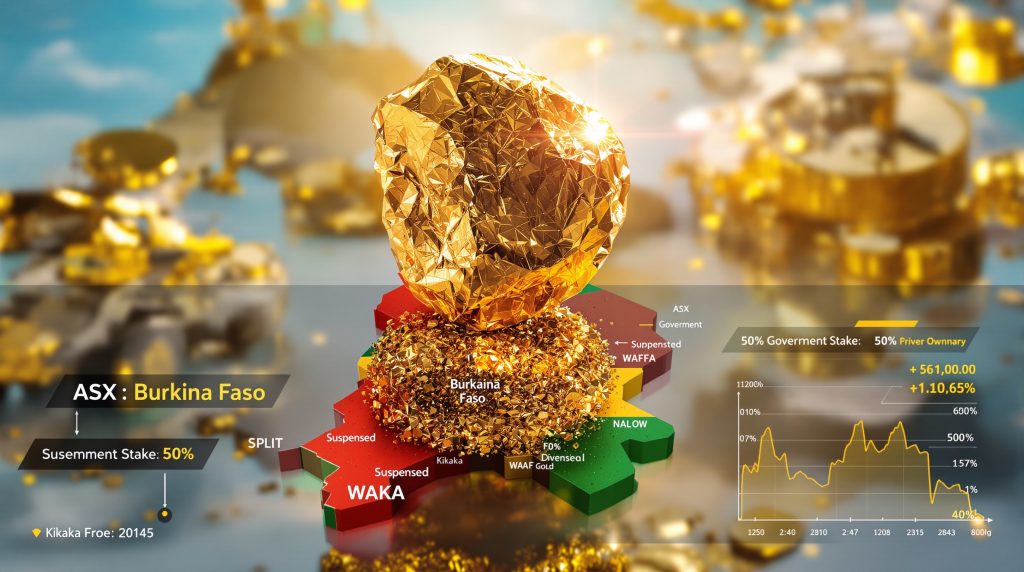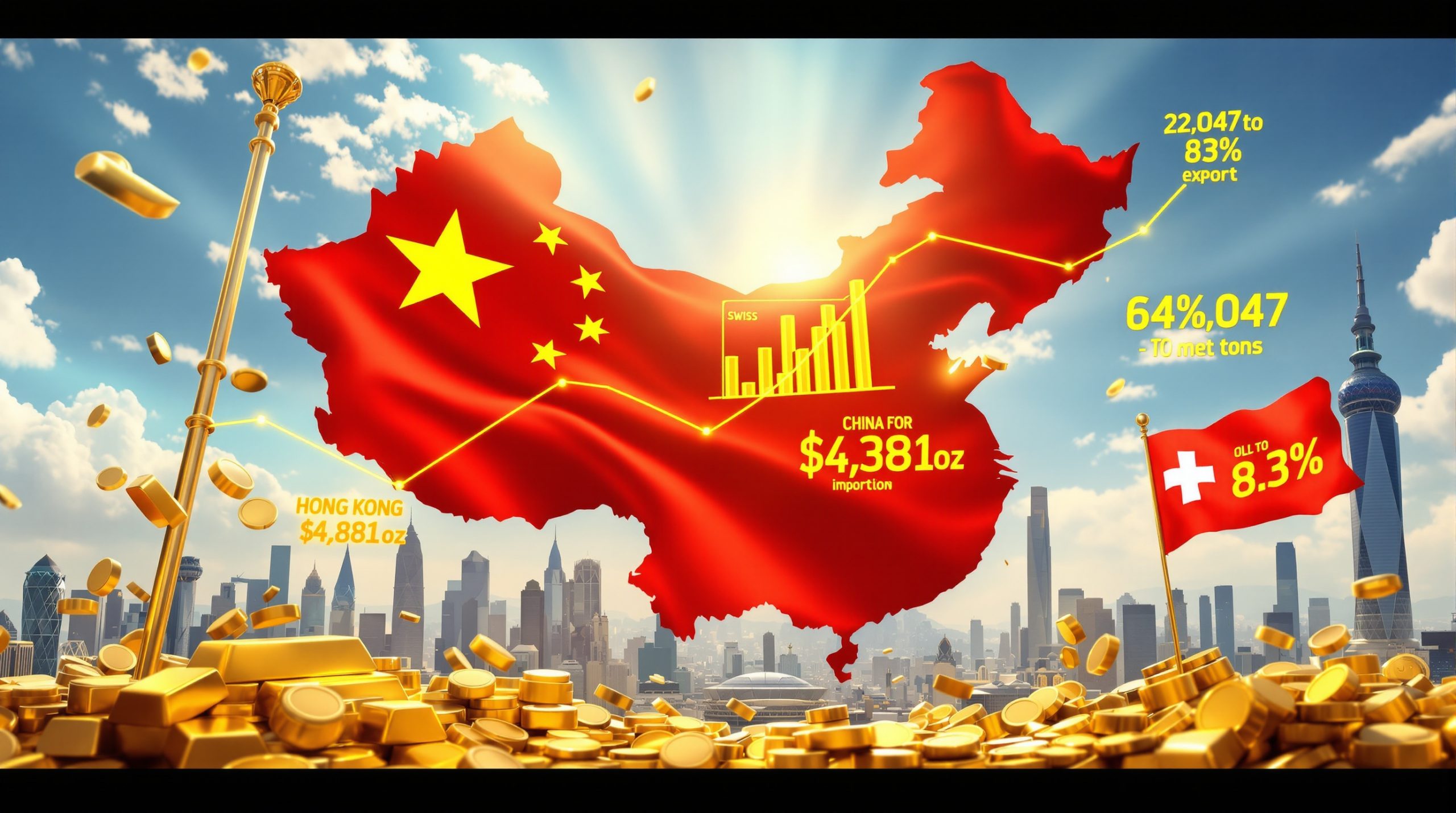ASX Trading Suspension: West African Resources Faces Burkina Faso's Stake Acquisition Bid
The Australian Securities Exchange (ASX) has suspended trading of West African Resources (WAF) shares following a significant development in Burkina Faso. The West African nation's government has proposed acquiring an additional 35% stake in WAF's Kiaka gold project, which would increase the government's total ownership to 50%. This suspension came after WAF failed to provide timely information about this material development, leaving investors in the dark about potential impacts on the company's operations and financial outlook.
The trading suspension represents a critical moment for both WAF and the broader mining investment landscape in West Africa. With resource nationalism on the rise across the region, this development signals shifting power dynamics between foreign mining companies and host governments seeking greater control over natural resources.
What Triggered the ASX Trading Suspension of West African Resources?
The immediate trigger for the trading suspension was WAF's failure to provide adequate disclosure about the Burkina Faso government's proposal to increase its stake in the Kiaka gold project. Under ASX listing rules, companies must promptly inform the market about developments that could materially impact share prices or investment decisions.
The Burkina Faso government's proposal would significantly alter the ownership structure of one of WAF's key assets. Currently, the government holds a 15% free-carried interest in the project—meaning it isn't required to contribute financially to development costs. The proposed acquisition would add another 35% stake, bringing total government ownership to 50% and fundamentally changing the project economics for WAF and its shareholders.
This move comes amid a broader push for resource sovereignty in Burkina Faso under the leadership of Captain Ibrahim Traoré, who came to power in 2022. The government appears determined to exercise greater control over the country's natural resources, particularly its gold reserves, which represent a crucial source of foreign exchange and revenue.
How Did the Trading Suspension Unfold?
The sequence of events leading to the trading suspension followed a pattern typical of ASX regulatory interventions in cases of incomplete disclosure:
-
On August 28, 2025, WAF requested a standard trading halt to prepare a comprehensive statement regarding the government's offer.
-
Trading halts typically last up to two business days, giving companies time to formulate appropriate market announcements about material developments.
-
When WAF failed to provide the required information within this timeframe, the ASX escalated the measure from a halt to a full suspension.
-
Unlike a trading halt, which has a defined duration, a suspension remains in effect indefinitely until the company satisfies regulatory requirements for disclosure.
The ASX's decision to convert the trading halt into a suspension indicates the seriousness of the situation and the market operator's concern about protecting investors from trading without access to complete information. For WAF shareholders, this suspension creates uncertainty about when they might regain the ability to trade their shares and what value those shares might hold when trading resumes.
What Are the Financial Implications of the Proposed Stake Acquisition?
The financial stakes in this situation are substantial. The Kiaka gold project represents a cornerstone asset in WAF's portfolio, with projected annual production that would generate significant revenue and potential profits over a multi-decade operational lifespan.
Table: Kiaka Gold Project Key Metrics
| Metric | Value |
|---|---|
| Annual Production | 234,000 ounces |
| Mine Lifespan | 20 years |
| Estimated Annual Revenue | ~$795 million (at current gold prices) |
| Current Government Stake | 15% |
| Proposed Government Stake | 50% |
| Total Life-of-Mine Gold | 4.68 million ounces |
| Development Capital | $450-500 million (estimated) |
The financial implications extend beyond simple ownership percentages. Key considerations include:
-
Profit Distribution: A 50% government stake would drastically reduce WAF's share of profits from the operation.
-
Development Financing: Questions remain about whether the government's increased stake would come with proportional responsibility for funding remaining development costs.
-
Investment Recovery Timeline: The altered ownership structure could significantly extend the period required for WAF to recover its initial investment.
-
Valuation Impact: Analysts will need to recalculate net present value models for the Kiaka project based on the new ownership structure.
-
Portfolio Rebalancing: WAF may need to reevaluate its overall investment allocation across its Burkina Faso assets, which also include the Sanbrado and Toega gold mines.
The company faces complex negotiations ahead, balancing shareholder interests against the political reality of operating in a jurisdiction where the regulatory landscape is rapidly evolving.
How Does This Align With Burkina Faso's Mining Code?
The government's move to increase its stake in the Kiaka project aligns with Burkina Faso's 2024 mining code, which represents a significant shift in the country's approach to resource governance. This updated code strengthens the government's position in mining operations through several key provisions:
-
Increase in mandatory free-carried equity from 10% to 15%
-
Provision for additional state acquisition of "at least 30%" paid interest in strategic mining projects
-
Mandatory 15% priority dividend payment to the government from company profits
-
Enhanced local content requirements for mining operations
-
Greater government oversight of production and sales
-
Stricter environmental compliance standards
The code reflects Burkina Faso's determination to maximize benefits from its natural resources while maintaining sufficient investment attractiveness to keep operations viable. However, the implementation approach—particularly the timing and terms of stake acquisitions—has created uncertainty in the mining investment community.
Industry observers note that while the code technically allows for these acquisitions, the manner and timing of implementation can significantly impact investor confidence. Companies generally expect regulatory stability and gradual transitions when major changes occur in mining regulations.
What Broader Trends Does This Reflect in West African Mining?
This development is part of a wider trend of resource nationalism across West Africa, where governments are increasingly asserting control over their natural resources. The region has witnessed several similar initiatives in recent years:
-
Mali's Mining Code Reforms: Mali introduced reforms requiring renegotiation of existing mining agreements, leading to protracted discussions between the government and operators like Barrick Gold.
-
Guinea's Bauxite Industry: The government has pushed for greater local processing requirements and increased state participation in mining projects.
-
Ghana's Royalty Adjustments: Periodic reviews of fiscal terms have resulted in higher government take from mining operations.
Regional Resource Sovereignty Initiatives:
-
Burkina Faso's creation of SOPAMIB (Société de Participation Minière du Burkina) to manage government mining interests
-
Transfer of five gold assets to state control in June 2025, including the Boungou and Wahgnion mines previously operated by Endeavour Mining
-
Similar resource control measures in Mali and other Sahel region countries
-
Increased focus on domestic benefits from natural resource extraction
-
Push for local processing and value addition rather than pure extraction
This regional trend represents a significant shift from the investment-friendly policies that characterized much of the 2000s and 2010s, when many West African countries sought to attract foreign capital to develop their mining sectors. Today's governments are more focused on ensuring greater domestic benefits from these resources, even if that means accepting some reduction in new investment.
What Are the Potential Outcomes for West African Resources?
WAF now faces several potential scenarios as it navigates this challenging situation:
-
Negotiated Settlement: The company could reach an agreement with the Burkina Faso government on terms for the stake transfer that protect core shareholder interests while accommodating the government's objectives. This might include:
- Phased implementation of ownership changes
- Compensation mechanisms for the transferred equity
- Guarantees regarding future regulatory stability
-
International Arbitration: If WAF considers the terms unreasonable or the process improper under international investment law, it might seek arbitration through mechanisms provided in bilateral investment treaties or mining agreements.
-
Operational Restructuring: The company could restructure its Burkina Faso operations to optimize returns under the new ownership structure, potentially including:
- Cost reduction initiatives
- Revised development timelines
- Modified extraction strategies to prioritize higher-grade zones
-
Strategic Review: WAF might initiate a broader strategic review of its presence in Burkina Faso, considering:
- Portfolio rebalancing across its three gold projects
- Potential divestment options
- Geographic diversification into other jurisdictions
The company's ability to navigate this situation will be crucial for its future in Burkina Faso, where it also operates the Sanbrado and Toega gold mines. The resolution will likely set precedents for how other international mining companies approach their operations in the country.
How Might This Impact Other Mining Companies in Burkina Faso?
The government's approach to WAF could establish precedents for other international mining companies operating in Burkina Faso. Companies potentially affected include:
-
Endeavour Mining: Operating the Houndé and Mana gold mines
-
Orezone Gold: Developing the Bomboré gold project
-
Iamgold: Operating the Essakane gold mine
-
Fortuna Silver Mines: Operating the Yaramoko gold mine
-
Various junior mining companies: With exploration or development projects throughout the country
These companies will be closely monitoring how negotiations proceed and what terms are ultimately agreed upon, as similar requests could potentially be made regarding their operations. Key aspects they'll be watching include:
-
Valuation Methodology: How the government values the stake it wishes to acquire
-
Compensation Terms: Whether and how companies are compensated for transferred equity
-
Implementation Timeline: How quickly any ownership changes are expected to occur
-
Operating Control: Whether majority government ownership affects day-to-day operational control
-
Profit Repatriation: Any new restrictions on how companies can use or repatriate profits
The outcome will likely influence investment decisions not only in Burkina Faso but potentially across the broader West African region, as industry consolidation trends become more pronounced and investors assess whether similar approaches might be adopted by neighboring countries.
What Is the Context of Burkina Faso's Gold Industry?
As Africa's fourth-largest gold producer according to the World Gold Council, Burkina Faso's mining sector is vital to its economy. Gold represents over 75% of the country's export earnings and contributes significantly to government revenue and GDP.
The gold mining industry in Burkina Faso has evolved significantly over the past two decades, transitioning from artisanal operations to industrial-scale mining dominated by international companies. This evolution has brought both benefits and challenges:
Gold Mining in Burkina Faso:
-
Major contributor to national GDP, accounting for approximately 15% of economic output
-
Primary source of export earnings and foreign exchange
-
Significant formal sector employer in a predominantly agricultural economy
-
Growing production capacity, with output more than doubling over the past decade
-
Increasing focus on local processing and value addition rather than pure extraction
-
Persistent challenges with artisanal mining, which operates largely outside regulatory frameworks
-
Security concerns in some mining regions due to regional instability
The government's push for greater control comes amid rising gold prices, which have enhanced the sector's economic importance. Current gold prices near historical highs make mining assets particularly valuable and provide strong incentives for the government to maximize national benefits from these resources.
At the same time, the country faces complex developmental challenges that increase pressure on the government to demonstrate tangible benefits from natural resource extraction to the broader population.
What's Next in This Developing Situation?
The immediate next steps in this situation will be critical for WAF, its shareholders, and the broader mining investment community in West Africa:
-
Comprehensive Disclosure: WAF must issue a detailed statement on the government's proposal to satisfy ASX requirements and potentially resume trading.
-
Negotiation Process: Formal discussions between WAF and the Burkina Faso government will likely commence to determine if mutually acceptable terms can be reached.
-
Shareholder Communication: WAF will need to engage with its shareholders about potential impacts and strategic responses.
-
Market Reaction: Once trading resumes, market participants will price in their assessment of the situation's impact on WAF's value.
-
Industry Response: Other mining companies operating in Burkina Faso may need to evaluate their positions and potentially engage with the government about their own projects.
The resolution of this situation will have implications not only for WAF but potentially for the broader mining investment landscape in West Africa. It represents a test case for how resource nationalism can be balanced with the continued need for foreign investment and expertise in developing mineral resources, similar to the Paladin trading suspension case that occurred earlier this year.
FAQ: Key Questions About the WAF Trading Suspension
Why did the ASX suspend trading rather than continue the trading halt?
The ASX converted the trading halt to a suspension because WAF failed to provide the required detailed information within the standard timeframe. Trading halts typically last for a maximum of two trading days, after which companies must either resume trading or face suspension if disclosure requirements haven't been met. The suspension protects investors from trading without access to material information.
How does the 50% ownership structure compare to industry norms?
A 50% government ownership stake is significantly higher than traditional mining arrangements in most jurisdictions, where government participation typically ranges from 10-20%. While some state-owned enterprises in countries like China or Chile may hold majority stakes in mining operations, this level of government ownership is uncommon for projects primarily developed by international mining companies. The proposed structure would place the Kiaka project at the upper end of state participation levels globally.
What signals does this send to other mining investors considering Burkina Faso?
The move signals increased sovereign risk for mining investments in Burkina Faso, potentially impacting future capital allocation decisions by international mining companies. Investors typically seek jurisdictions offering a combination of geological potential and regulatory stability. While Burkina Faso's gold resources remain attractive, the changing ownership requirements may lead companies to demand higher expected returns to compensate for perceived increases in political risk, or to prioritize investment opportunities in countries with more predictable regulatory environments.
How might this affect Burkina Faso's mining sector development?
While increasing government revenue in the short term, aggressive resource nationalism could potentially deter future investment, affecting long-term sector growth and development. The ultimate impact will depend on how the government implements its policies and whether it can strike a balance that satisfies both national interests and investor requirements. Countries that have successfully managed resource nationalism typically maintain clear rules, transparent processes, and respect for existing agreements while gradually implementing changes to increase domestic benefits.
Further Exploration:
For mining professionals and investors seeking to understand the broader context of these developments, several factors merit further consideration:
Regional Security Dynamics: The Sahel region, including Burkina Faso, faces ongoing security challenges that impact mining operations. Companies must evaluate both regulatory and security risks when making investment decisions.
Commodity Price Cycles: Government approaches to resource ownership often correlate with commodity price cycles. The current strong gold market strategies provide leverage to resource-rich countries that may not exist during price downturns.
Alternative Investment Destinations: Mining companies increasingly benchmark jurisdictions against each other when making investment decisions. Understanding how Burkina Faso's approach compares to alternatives in Africa and globally provides important context.
Community Relations: Beyond government relations, successful mining operations require positive relationships with local communities. Companies must balance multiple stakeholders' interests when developing and operating projects.
The evolving situation with West African Resources highlights the complex interplay between commercial interests, national development objectives, and changing perceptions about how natural resource wealth should be distributed. As the Mining.com reports, Burkina Faso's nationalization efforts are rattling the entire West African gold sector. Additionally, according to ShareCafe, the suspension has already impacted investor confidence in the region's mining prospects. As the global mining industry continues to evolve, finding sustainable models that benefit both investors and host countries remains a central challenge.
Ready to Invest in African Mining Despite Geopolitical Challenges?
Discover how real-time alerts on significant ASX mineral discoveries can help you identify actionable investment opportunities ahead of resource nationalism trends. Visit Discovery Alert's discoveries page to learn how their proprietary Discovery IQ model turns complex mining data into informed investment decisions.




